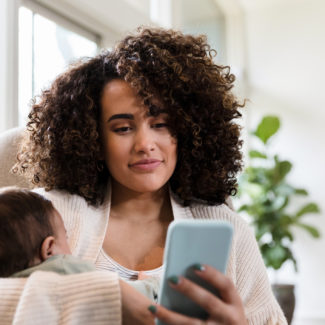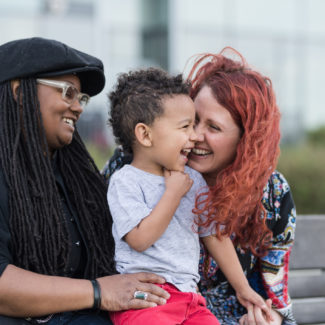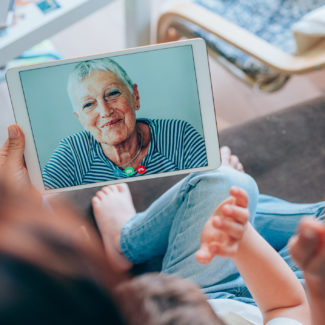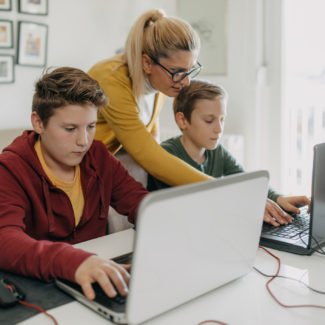This article originally appeared in Macaroni Kid on January 20, 2021, by Luanne Starr Rhoades, LCPC, LADC, CCS; Health Affiliates Maine.
Question: I am a new mom and COVID has been very difficult. My husband works out of the home and I feel very isolated. We are not seeing my parents right now even though they live close because they are high risk. I so appreciate Macaroni Kid as a resource but am missing in-person events and the ability to mingle with other moms. Can you share ideas for trying to stay connected and beat the heavy feeling of isolation? I am particularly worried with winter here that it will just get worse.
Answer: I can just imagine how badly you are missing in-person events and the ability to mingle with family and other moms. You are missing the fun of showing off your new baby to the world, and especially enjoying seeing your parents with their grandchild. This pandemic has really emphasized for all of us what really matters and the things we took for granted. New parenting should be a well-supported endeavor, and it’s not meant to be done alone.
There are many things to do to take care of a new baby. I am going to add one more important job to your list and that is to take care of yourself. This is so important when you are feeling isolated. You will have to work to stay connected and fight the feelings of sadness that can often do just the reverse—cause you to withdraw.
Not knowing your parents’ conditions, I am not sure if this can apply to your circumstance, but as long as you wear a mask and stay six feet apart, there are some activities you can do together. Outdoor activities are best.
Here are a few ways to stay connected with loved ones, other parents, and your community:
- Bundle up the baby for brief porch visits. Let folks know you are coming so they can bundle up, too!
- Try “car talk.” Park next to each other in opposite directions and talk for as long as you can handle the open window temperatures. Enjoy a hot drink while you chat.
- Text pictures of the little one daily to your parents and in-laws. They will love it since they are probably feeling isolated and alone, too. Everyone will feel more engaged.
- Should baby nap long enough, bake something for your parents and make a delivery so they can get a quick peek at the little one.
- There are many online groups. Try one on Facebook specifically for those who welcomed a baby during COVID called “COVID-19 Baby Parents Group.” These types of groups are just a chat forum to support one another and share ideas and resources.
- Make sure you are letting your husband know how isolated you feel. He may be doing it already, but if not, ask that your husband check in on you during his work breaks.
- Make a list of those friends and family for whom you can have regular contact whether by phone, Skype, Facetime, email, or car talk. Ask them for regular virtual or phone visits. Most importantly, let them know how you are feeling. You will find others feel as you do.
- Don’t let cold weather keep you from attending outdoor events. Most town recreation centers have developed “safe” family or kid activities to do which can connect and get families out of the house. Some are ongoing weekly events like skating, snowshoeing, or winter walks. One mom told me that she has enjoyed this so much. She bundles up her daughter and puts her in the sled at the event. It is a great place to meet other moms. The fresh, cool air can invigorate both mom and baby, giving you energy.
- Some local farms are allowing families to visit the animals in the barns. Call ahead and ask. The sights, sounds, and smells of the working farm can make for a wonderful adventure.
- Reach out to other new moms you may know. Share with them how you are feeling.
- Think of someone in your circle of acquaintances who might also be feeling isolated. In helping others, we often help ourselves.
- Connect to a counselor via teletherapy. Most insurances will pay for this. There are many uncertainties in being a new mom even in times when accessing regular supports is easy. It is common for new parents to experience stress, anxiety, and some experience postpartum depression. The challenges of new parenting are emphasized during a pandemic. Asking for help is the act of a healthy person.
Stay hopeful! Try something on this list each day. Dwell on thoughts when the pandemic will end and of all things you will want to do and explore with your child. Do not hesitate to reach out for help. We will get through this.
Luanne Starr Rhoades, LCPC, LADC, CCS is a professional counselor and the Outpatient Therapy Director at Health Affiliates Maine.
Sign Up To Receive Our Latest Blog Posts!
Learn more tips on living well and understanding mental illness. Help to end the stigma, and hear inspiring stories of recovery. Sign up here!










